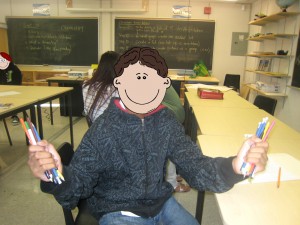A New Approach to Classroom Expectations
Every year I discuss classroom expectations with my students. Each year, this conversation looks somewhat different, but it generally involves asking students for input. I have heard some teachers say that “developing classroom expectations with students allows them to feel some ownership of the rules, and they are more likely to follow them.” I don’t really believe that. In my experience, students know all the right answers, which is why every list of classroom expectations I have ever seen looks pretty much the same.
I feel that asking students for input on the classroom expectations is really a token gesture – it looks like a nice thing to do, but it’s not really a useful way to have a lasting impression on student behaviour. The important part of generating a list of classroom expectations with your students in not what they come up with on the list, but how they come up with the list. It is the process of generating a list of expectations that helps to establish the tone of the classroom. Do you ask students to work collaboratively? Do you encourage students to be creative in the presentation of their ideas? Do students feel it is safe to contribute? Does each student have a voice?
This year I tried something new. First, I asked students to write down 5 expectations that all people (including the teacher) should always uphold while in the classroom in order to make it a better place to be. Next, I asked students to form small groups and consolidate their lists. Finally, we generated a list as a class by including only the expectations that showed up in more than one group. This all took 20 minutes. So far … so good … and pretty boring!
The next stage was to assign certain expectations to each group (it worked out to be at least two each.) The groups were asked, “what does the expectation look like? how will we know we are doing it?” – this generated some good discussion in the groups. I then asked students to come up with a “picture” that we will take with a digital camera to remind us what the expectation looks like.
 I had to give the students an example: “If the expectation was, come to class prepared, we could take a picture of a student holding all of the necessary materials – pencils, paper, etc.” The students immediately started talking in their groups about how they would capture their assigned expectations. What would they do? Who would they involve? Did they need props? Should they do multiple images? All of this great discussion came out! Most important to me, the students were collaborating on a task that was not clearly defined. They needed to be creative; they needed to be problem solvers; they needed to communicate and compromise. All of this interaction is what builds community in the classroom, not this list of expectations!
I had to give the students an example: “If the expectation was, come to class prepared, we could take a picture of a student holding all of the necessary materials – pencils, paper, etc.” The students immediately started talking in their groups about how they would capture their assigned expectations. What would they do? Who would they involve? Did they need props? Should they do multiple images? All of this great discussion came out! Most important to me, the students were collaborating on a task that was not clearly defined. They needed to be creative; they needed to be problem solvers; they needed to communicate and compromise. All of this interaction is what builds community in the classroom, not this list of expectations!
Finally, we took 10 minutes or so to set up each of the photographs, and captured the pictures with my digital camera. My students really seemed to enjoy the activity and I feel that they left the class that day with a greater sense how to work effectively together, and a stronger image in their minds of the classroom expectations we generated.
That night, I went home and uploaded the pictures to Animoto, found some music licensed for use with Creative Commons and put together a short slide show to watch in class. I have shown the video at the beginning of class for a few days. The students think that it’s pretty cool because it is their photos in the video and the video is much more engaging than a list on the wall. From now on, I will only need to show the video if I feel that the class needs a gentle reminder.
For your viewing pleasure, I have embedded a modified version of our classroom expectations video. In order to protect the identities of my students, I have put cartoons over their faces. In general, I tried not to change the wording of the expectations that the students came up with. I wanted them to feel that this video came from them and not from me. Also, because each photo was part of a larger conversation we had in class, the image probably communicates more to my students than it might to you. Enjoy!
Pingback: Tweets that mention A New Approach to Classroom Expectations | ideaconnect -- Topsy.com
Pingback: Levels of Classroom Management | ideaconnect